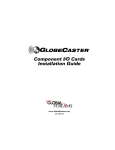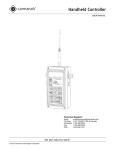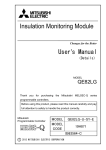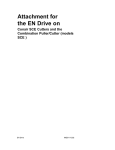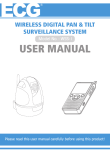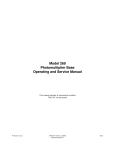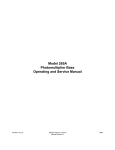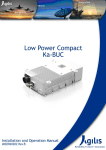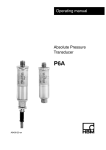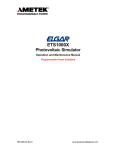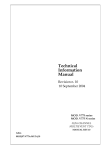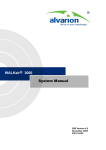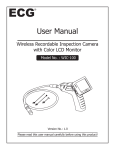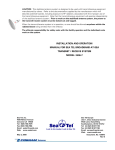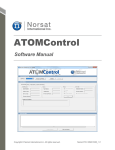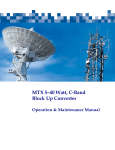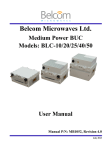Download IM-T8319 - New Japan Radio
Transcript
IM-T8319 Rev.01 Instruction Manual for Ku-band 16W BUC [NJT8319 series] Document Part Number: IM-T8319 Revision: 01 Issue Date: April 30, 2014 Copyright © 2014, New Japan Radio Co., Ltd. All rights reserved. This instruction manual may not be reproduced, in part or in whole, without the permission of New Japan Radio Co., Ltd. The specifications and information regarding the products in this instruction manual are subject to change without notice. All statements, information, and recommendations in this instruction manual are believed to be accurate but are presented without warranty of any kind, express, or implied. Users must take full responsibility for their application of any products. NJT8319 series Instruction Manual Page 1 IM-T8319 Rev.01 General Caution 1. NJRC strives to produce reliable and high quality microwave components. NJRC's microwave components are intended for specific applications and require proper maintenance and handling. To enhance the performance and service of NJRC's microwave components, the devices, machinery or equipment into which they are integrated should undergo preventative maintenance and inspection at regularly scheduled intervals. Failure to properly maintain equipment and machinery incorporating these products can result in catastrophic system failures. 2. To ensure the highest levels of reliability, NJRC products must always be properly handled. The introduction of external contaminants (e.g. dust, oil or cosmetics) can result in failures of microwave components. 3. NJRC offers a variety of microwave components intended for particular applications. It is important that you select the proper component for your intended application. You may contact NJRC's sales office or sales representatives, if you are uncertain about the products listed in the catalog and the specification sheets. 4. Special care is required in designing devices, machinery or equipment, which demand high levels of reliability. This is particularly important when designing critical components or systems whose foreseeable failure can result in situations that could adversely affect health or safety. In designing such critical devices, equipment or machinery, careful consideration should be given to, amongst other things, their safety design, fail-safe design, back-up and redundancy systems, and diffusion design. 5. The products listed in the catalog and specification sheets may not be appropriate for use in certain equipment where reliability is critical or where the products may be subjected to extreme conditions. You should consult our sales office or sales representatives before using the products in any of the following types of equipment. * Aerospace Equipment * Equipment Used in the Deep Sea * Power Generator Control Equipment (nuclear, steam, hydraulic) * Life Maintenance Medical Equipment * Fire Alarm/Intruder Detector * Vehicle Control Equipment (automobile, airplane, railroad, ship, etc.) * Various Safety Equipment NJT8319 series Instruction Manual Page 2 IM-T8319 Rev.01 General Caution (continued) 6. NJRC's products have been designed and tested to function within controlled environmental conditions. Do not use products under conditions that deviate from methods or applications specified in the catalog and specification sheets. Failure to employ NJRC's products in the proper applications can lead to deterioration, destruction or failure of the products. NJRC shall not be responsible for any bodily injury, fires or accidents, property damage or any consequential damages resulting from the misuse or misapplication of its products. PRODUCTS ARE SOLD WITHOUT WARRANTY OF ANY OF KIND, EITHER EXPRESS OR IMPLIED, INCLUDING BUT NOT LIMITED TO ANY IMPLIED WARRANTY OF MERCHANTABILITY OR FITNESS FOR A PARTICULAR PURPOSE. NJT8319 series Instruction Manual Page 3 IM-T8319 Rev.01 About This Instruction Manual This instruction manual describes Ku-band 16W BUCs (Model No.: NJT8319 series) herein referred to as "the Unit". This instruction manual provides information and instructions for installation and operation of the Unit. This instruction manual is intended for use by trained field installers or system engineers responsible for satellite networks. Updated instruction manual may be available from NJRC's sales group [email protected]. Contents 1. Introduction ……………………………………………………………………………… 5-6 2. Safety Instructions …………………………………………………………………… 7 - 10 3. Packing List ……………………………………………………………………………… 11 4. Overview …………………………………………………………………………………… 12 5. Physical Description ………………………………………………………………… 13 - 16 6. Installing …………………………………………………………………………………… 17 - 21 7. GUI of Monitor and Control……………………………………………………… 22 8. Maintenance ……………………………………………………………………………… 23 9. Specification ……………………………………………………………………………… 24 - 28 NJT8319 series Instruction Manual Page 4 IM-T8319 Rev.01 1. Introduction This instruction manual is for Ku-band 16W BUCs (Model No.: NJT8319 series) . The Unit receives a reference signal (10 MHz) and an IF signal (L‐Band: 950 to 1,450 MHz or 950 to 1,700 MHz) input and transmits an RF signal (Standard Kuband: 14.0 to 14.5 GHz or Universal Ku‐band: 13.75 to 14.5 GHz) output. The Unit comes in a single, weatherized housing rated for outdoor use. The Unit has either an N-Type or a F-type female connector input, a WR75 waveguide with grooved flange output, and optional MS connector for DC power input. The Unit is operated by +48 V DC power (Range: +36 to +60 V) input. The Unit has the function of Monitor and Control which is complied with FSK communication and RS-232C interfaces NJT8319 series Instruction Manual Page 5 IM-T8319 Rev.01 The Unit has the following line-up: NJT8319 series Instruction Manual Page 6 IM-T8319 Rev.01 2. Safety Instructions Use the following safety guidelines to help protect the Unit from potential damage and to help ensure your own personal safety. DANGER, WARNING, CAUTION, and NOTE Statements DANGER, WARNING, CAUTION, and NOTE statements are used throughout this instruction manual to emphasize important and critical information. You must read these statements to help ensure safety and to prevent product damage. The statement are defined below. Statement DANGER Symbol Description DANGER indicates an imminently hazardous situation which, if not avoided, will result in death or serious injury. WARNING WARNING indicates a potentially hazardous situation which, if not avoided, could result in death or serious injury. CAUTION CAUTION indicates a potentially hazardous situation which, if not avoided, could result in minor or moderate injury. CAUTION may also be used to indicate other unsafe practices or risks of property damage. NOTE is used to notify of installation, operation, or maintenance information that is important, but not hazardrelated. NOTE NJT8319 series Instruction Manual Page 7 IM-T8319 Rev.01 Symbol Description GENERIC HAZARD ELECTRIC HAZARD HOT SURFACE MOVING PARTS When installing the Unit, observe the following safety guidelines. 2.1. Safety Statements 1. Opening / Removing DO NOT dismantle this product. Dismantlement may cause malfunction and electric shock. 2. Input Voltage Only input a voltage within the range indicated in specified voltage. DO operate at the input voltage of +36 to +60 V DC power. NJT8319 series Instruction Manual Page 8 IM-T8319 Rev.01 3. RF Radiation A radiation hazard exists if the BUC is operated with its RF signal output unterminated. DO NOT operate the BUC without a load or termination attached to the RF signal output. 4. High Temperatures DO NOT touch the body, especially fins, during operating the Unit. High touch temperatures may exist, depending on load conditions. 5. Fan DO NOT insert your finger into the fan to avoid injury. DO NOT insert any objects into the fan. Keep any objects away from the fan. Incorrect usage may cause injury to self or others. 6. Input Level DO NOT input an IF signal over the range of +13 dBm maximum and a reference signal within the range of -5 to +5 dBm. 7. Operating Temperature. Operate the Unit within the ambient temperature range of -40 to +75 degree C, but the performance guarantee temperature range is -40 to +55 degree C. NJT8319 series Instruction Manual Page 9 IM-T8319 Rev.01 2.2. Instruction Statements 1. Mounting 2. Connector DO NOT block the fins and air flow. Normally the Unit should be mounted with fan face down. When attaching cable, DO tighten as connector with following torque: N-type connector, 0.68 to 1.13 N・m F-type connector, 0.39 to 0.49 N・m 3. Weatherproof The Unit is mounted outdoors must be adequately weatherproofed. Ensure the waveguide joints are properly sealed with the supplied o-ring (gasket). Use self-amalgamating tape to seal connectors and cable entry points from the connector to the 4. Fan 5. Warranty The fan has its lifetime. The fan is to be replaced with a new one at appropriate interval. The recommendation interval of replacement is five years. Opening or removing any component (e.g. label, and screws) without fan equipments or sealed area will immediately void the warranty. NJT8319 series Instruction Manual Page 10 IM-T8319 Rev.01 3. Packing List The Unit is shipped in a single shipping container with the following content: No. 1. Qty 1 unit 2. 1 set 3. 4. 1 sheet ( 1 pc ) Description BUC: NJT8319N NJT8319F NJT8319NM NJT8319FM NJT8319NK NJT8319FK NJT8319NMK NJT8319FMK NJT8319NMR NJT8319FMR NJT8319UN NJT8319UF NJT8319UNM NJT8319UFM NJT8319UNK NJT8319UFK NJT8319UNMK NJT8319UFMK NJT8319UNMR OR NJT8319UFMR Accessory: Qty(4), Hexagon Socket Head Bolt (M4x10) Qty(1), Hexagon Wrench Key (M4) Qty(2), Phillips-head Screw (M6x10) Qty(1), O-ring Date sheet Mating MS Connector: Part Number: PT06E-14-12S (470) * MS connector is enclosed in the shipping container the only MS Connector models NJT8319 series Instruction Manual Page 11 IM-T8319 Rev.01 4. Overview The Unit transmits an RF signal (Universal Ku‐band: 13.75 to 14.5 GHz / Standard Ku-band: 14.0 to 14.5 GHz) output with up to 16W (+42 dBm) linear. The unique features are ・ High Temperature Operating: * Operation Guarantee Temperature Range: -40 to +75 degree C ・ RF Frequency Line-up: * Universal Ku-band: 13.75 to 14.5 GHz * Standard Ku-band: 14.0 to 14.5 GHz ・ High Efficiency & Low Distortion. * P1dB: +42 dBm min. over temperature * IM3: -28 dBc @ Pout = +39 dBm * Power Consumption: 160 W typ. ・ Monitor & Control Line-up * FSK Communication M&C * RS-232C Interface Serial M&C ・ Smaller Size & Lighter Weight * Dimension: 180 (L) x 130 (W) x 80 (H) mm * Weight: 2.4 kg ・ LED Indicator ・ RoHS Compliance Block Diagram NJT8319 series Instruction Manual Page 12 IM-T8319 Rev.01 5. Physical Description This section describes appearance and outline for the Unit. 5.1. Appearance Overall Picture NJT8319 series Instruction Manual Page 13 IM-T8319 Rev.01 5.2. Outline Drawing NJT8319 series Instruction Manual Page 14 IM-T8319 Rev.01 5.3. Description of Connectors, and LEDs Item N-type or F-type Female Connector Description IF Signal Input Reference Signal Input Purpose The Unit receives an IF signal (950 to 1,450 MHz or 950 to 1,700 MHz) via this connector. The Unit receives a reference signal (10 MHz) via this connector. FSK Communication M&C Signal Circular Connector (MS Connector) FSK Communication M&C models are only equipped. The Unit receives / transmits the M&C signal with the FSK modulation via this connector. DC Power Input *1 The Unit is required to supply +36 to +60 V DC power via this connector. DC Power Input *1 MS Connector models are only The Unit is required to supply +36 to +60 V DC power via Pin# J and K in this connector. RS-232C Interface RS-232C Interface M&C models are M&C Signal only equipped. The Unit receives / transmits the M&C signal with the RS-232C interface Pin# G, H and K in this connector. Connector Information Part No.: PT02E-14-12P (025) Mating connector: PT06E-14-12S (470) Assignment: * Pin G: RS-232C TxD and Pin H: RS-232C RxD are available for only RS-232C Interface M&C models. * Do not connect the pins for N.C. and not using pins with the cable wires. NJT8319 series Instruction Manual Page 15 IM-T8319 Rev.01 Item WR-75 Description RF Output LED Indicator Local Unlock Alarm Grounded Hole M6 hole Purpose The Unit transmits an RF signal (14.0 to 14.5 GHz or 13.75 to 14.5 GHz) via this waveguide. GREEN: L.O. locked RED: L.O. unlocked (or no reference signal) Common chassis ground *1: MS Connector models are available to apply DC voltage via Circular Connector (MS Connector) or N-/F-type Female Connector. DO NOT apply DC voltage via both Circular Connector (MS Connector) and N-/F-type Female Connector. If DC voltage is applied on both connectors, it may damage the unit or the unit may not operate properly. NJT8319 series Instruction Manual Page 16 IM-T8319 Rev.01 6. Installing This section describes basic installation for the Unit. 6.1. Mounting Configuration The Unit can be mounted in the feed horn of the satellite antenna. 6.1.1. Guidelines for Attachment of OMT When attaching the OMT or the filter, you should follow the following steps: Step 1: Verify that the o-ring groove on the waveguide flange of the Unit is clean. Insert the enclosed o-ring (gasket) the groove as shown. Step 2: Secure the OMT or the filter to the Unit using the supplied enclosed bolts with 1.15 to 1.4 N・m torque as shown, when the thickness of the flange of the OMT or the filter is 3.5 to 5.0 mm. When the thickness is not 3.5 to 5.0 mm, you should prepare 6.1.2. Guidelines for Mounting When mounting on the OMT or the filter, you should follow the following cautions: ・ DO NOT block the fins and air flow. ・ Normally the Unit should be mounted with fan face down. NJT8319 series Instruction Manual Page 17 IM-T8319 Rev.01 6.2. Connecting System The Unit is connected two cables: ・ Coaxial Cable ・ Power Cable ・ Wire for Common Chassis Ground / Earthing ・ M&C Signal Cable 6.2.1. Connecting Coaxial Cable The Unit receives an IF signal and a reference signal via coaxial cable from modem, is required to supply +36 to +60 V DC power , receives an FSK communication M&C signal. Connecting the coaxial cable is proceeded with the following steps: Step 1: Connect the coaxial cable with N-type or F-type male connectors to the coaxial connector equipped with the Unit under following torque: N-type connector, 0.68 to 1.13 N・m F-type Connector, 0.39 to 0.49 N・m Step 2: Use self-amalgamating tape to seal connector and cable entry points from the connector to the cable sheath. Only input a voltage within the range indicated in specified voltage. DO operate at the input voltage of +36 to +60 V DC power at the coaxial connector on the Unit. DO NOT input an IF signal over the range of +13 dBm maximum and a reference signal within the range of -5 to +5 dBm. Connecting the coaxial cable NJT8319 series Instruction Manual Page 18 IM-T8319 Rev.01 6.2.2. Connecting Power Cable The Unit is required to supply +36 to +60 V DC power via power cable from modem or a DC power supply unit with the exception of only IF connecter supplied models. Connecting the power cable is proceeded with the following steps: Step 1: Assemble the power cable and the supplied MS mating connector with the following assignment: Pin J: Prime (+48 V DC Power) Pin K: Prime Return * Do not connect the pins for N.C. and not using pins with the cable wires. Step 2: Step 3: Connect the power cable above to MS connector equipped with a bayonet locked status. Use self-amalgamating tape to seal connector and cable entry points from the connector to the cable sheath. Only input a voltage within the range indicated in specified voltage. DO operate at the input voltage of +36 to 60 V DC power at the coaxial connector on the Unit. DO NOT apply DC voltage via both MS Connector and N-/F-type Female Connector. If DC voltage is applied on both connectors, it may damage the unit or the unit may not operate properly. Connecting the power cable NJT8319 series Instruction Manual Page 19 IM-T8319 Rev.01 6.2.3. Wire for Common Chassis Ground / Earthing The Unit can be had the chassis ground of the other equipment (e.g. antenna) in common or earthing. Connecting the wire for common chassis ground / earthing is proceeded with the following steps: Step 1: Connect the grounding/ earthing wire from ground on the other equipment or earthing point to the ground hole on connector or waveguide sides with M6 screw. Connect the grounding/ earthing wire OR Connect the grounding/ earthing wire NJT8319 series Instruction Manual Page 20 IM-T8319 Rev.01 6.2.4. Connecting M&C Signal Cable The Unit is required to supply RS-232C interface signal via signal cable from modem or M&C equipment in case that it is RS-232C interface M&C models. Connecting the M&C signal cable is proceeded with the following steps: Step 1: Assemble the M&C signal cable and the supplied MS mating connector with the following assignment: Pin G: RS-232C TxD Pin H: RS-232C RxD Pin K: GND COMMON (RS-232C) * Do not connect the pins for N.C. and not using pins with the cable wires. Step 2: Step 3: Connect the M&C signal cable above to MS connector equipped with a bayonet locked status. Use self-amalgamating tape to seal connector and cable entry points from the connector to the cable sheath. Connecting the M&C signal cable NJT8319 series Instruction Manual Page 21 IM-T8319 Rev.01 7. GUI of Monitor and Control This Section describes the NJR's Graphical User Interface (GUI) of Monitor and Control. The NJR's GUI is available for the RS-232C Interface M&C models. The GUI uses the BUC-EP001 software which can be downloaded from the following NJR's website. ・ Website: http://mc.njr.co.jp/eng/products/vsat/ku-buc/8w_2.html Please download a zip file of the GUI software and decompress this 7.1. Setup 7.1.1. Connecting the RS-232C Interface Connecting the the RS-232C Interface is proceeded with the following Step 1: Assemble the cable and the supplied MS mating connector with the following assignment: Pin G: RS-232C TxD Pin H: RS-232C RxD Pin K: GND COMMON (RS-232C) Step 2: Connect the MS connector and the COM port of user's PC with the above cable. 7.1.2. COM Port Setting Set the serial communication property of your PC as follows. Baud rate: 9600 Data bit: 8 Parity: none Stop bit: 1 Flow control: none 7.1.3. Installing the GUI Software The GUI Software can be installed by Setup.exe in the downloaded zip file. The details of Installing the GUI software are mentioned in the user manual which is stored in Manual.htm in the downloaded zip file. 7.2. Starting and Operating The details of starting and operating the GUI software are mentioned in the user manual which is stored in Manual.htm in decompressed folder. NJT8319 series Instruction Manual Page 22 IM-T8319 Rev.01 8. Maintenance This Section describes basic maintenance for the Unit. 8.1. Fan Field Replacement The Unit is Forced Air by fan for cooling. The fan has its lifetime. The fan is to be replaced with a new one at appropriate interval. The recommendation interval of replacement is five years. The fan of the Unit stop and does not operate normally, you need to replace a new fan by yourself in field. And the fan is to be replaced with a new one at five years interval. Contact to us by phone, fax, or email, when a new fan for replacement is needed. +81-49-278-1270 ・ Telephone: +81-49-278-1234 ・ Fax: ・ Email: [email protected] NJT8319 series Instruction Manual Page 23 IM-T8319 Rev.01 9. Specifications The Unit is in compliance with the following specifications: 9.1. Electrical Specifications No. Item 1. Output Frequency Range <Universal Ku-band> <Standard Ku-band> Input Frequency Range 2. <Universal Ku-band> <Standard Ku-band> Maximum IF Input Level 3. (without damage) 4. Conversion Type L.O. Frequency 5. <Universal Ku-band> <Standard Ku-band> 6. Frequency Sense Output Power @ 1dB G.C.P. 7. Linear Gain 8. 9. IM3 10. Requirement for External Reference [Frequency] [Input Power] [Phase Noise] 11. L.O. Phase Noise 12. Input Impedance <N-type Model> <F-type Model> Input VSWR Output VSWR Output Load VSWR for Non Damage 13. 14. 15. NJT8319 series Instruction Manual Specifications 13.75 to 14.5 GHz 14.0 to 14.5 GHz 950 to 1,700 MHz 950 to 1,450 MHz +13 dBm max. Single, fixed L.O. 12.80 GHz 13.05 GHz Positive +42 dBm min. over temperature 68 dB nom., 62 dB min. -28 dBc typ., -24 dBc max. @ total power <= +42 dBm - 3 dB 10 MHz (sine-wave) -5 to +5 dBm @ Input port -125 dBc/Hz max. @ 100 Hz -135 dBc/Hz max. @ 1 kHz -140 dBc/Hz max. @ 10 kHz -60 dBc/Hz max. @ 100 Hz -70 dBc/Hz max. @ 1 kHz -80 dBc/Hz max. @ 10 kHz -90 dBc/Hz max. @ 100 kHz -100 dBc/Hz max. @ 1MHz 50 ohms nom. 75 ohms nom. 2 : 1 max. 2 : 1 max. 2 : 1 max. Page 24 IM-T8319 Rev.01 No. 16. Item DC Power Requirement [Voltage Range] [Power Consumption] 17. Mute 18. LED Indicator 19. Monitor and Control <FSK Communication M&C> [Interface] [Functions] [Performance Specifications +48 VDC (+36 to +60 VDC) 140 W typ. @ No IF signal 160W typ., 180 W max. @ Pout = +42 dBm Shut off the HPA in case of L.O. unlocked GREEN: L.O. locked RED: L.O. unlocked (or no 10 MHz reference signal) 650kHz FSK Signal on IF Connector Monitor: Tx Output Power / Temperature / Tx Status / Alarm (Over temperature *2 / L.O. unlock) / Step Attenuator Control: Transmit On/Off / Step Attenuator Tx Output Power: Detector Range: 15 dB (up to P1dB) Reading Accuracy: +/- 1.0 dB Step Attenuator: Attenuator Range: 0 to 15.5 dB Attenuator Step: 0.5 dB * Details are mentioned on Appendix of “Monitor & Control Specifications for FSK Communications Interface”. NJT8319 series Instruction Manual Page 25 IM-T8319 Rev.01 No. 19. Item Monitor and Control <RS-232C Interface M&C> [Interface] [Functions] [Performance Specifications RS-232C Interface on MS connector Monitor: Tx Output Power / Temperature / Tx Status / Alarm (Over temperature *2 / L.O. unlock) / Step Attenuator Control: Transmit On/Off / Step Attenuator Tx Output Power: Detector Range: 15 dB (up to P1dB) Reading Accuracy: +/- 1.0 dB Step Attenuator: Attenuator Range: 0 to 15.5 dB Attenuator Step: 0.5 dB * Details are mentioned on Appendix of “Monitor & Control Specifications for RS232C Interface”. *2: Regardless of cooling fan status, the unit will operate until status of over temperature which turn out at internal temperature of around 120 °C, and the Mute and Alarm will function at status of over temperature. NJT8319 series Instruction Manual Page 26 IM-T8319 Rev.01 9.2. Mechanical Specifications: No. Item 1. Input Interface [IF Connector] [DC Input *3] Specifications N-type or F-type, female connector IF / Ref. / FSK M&C Signal (/ DC) Input IF Connector or MS Connector - MS connector Part No.: PT02E-14-12P (025) Mating connector: PT06E-14-12S (470) Assignment: 2. Output Interface 3. 4. Cooling Dimension & Housing without Interface Connector (L) (W) (H) Weight 5. * Pin G: RS-232C TxD and Pin H: RS232C RxD are available for only RS-232C Interface M&C models. * Do not connect the pins for N.C. and not using pins with the cable wires. Waveguide, WR75 with Grooved Flange Forced-air-cooled 180 mm [7.09"] 130 mm [5.12"] 80 mm [3.15"] 2.4 kg [5.3 lbs] *3: MS Connector models are available to apply DC voltage via MS Connector or N-/F-type Female Connector. DO NOT apply DC voltage via both MS Connector and N-/F-type Female Connector. If DC voltage is applied on both connectors, it may damage the unit or the unit may not operate properly. NJT8319 series Instruction Manual Page 27 IM-T8319 Rev.01 9.3. Environmental Specification: No. Item 1. Temperature Range (ambient) [Operating] [Storage] Specifications Operation Guarantee: -40 to +75 °C Performance Guarantee: -40 to +55 °C -40 to +75 °C 0 to 100 % 15,000 feet (4,572 m) 2. 3. 4. Humidity Altitude Vibration 5. Shock 6. Dustproof / Waterproof 7. 8. Regulatory Compliance CE / EMC Directive (2004/108/EC) Comply with RoHS (Restricting the use of Hazardous Substances) directives NJT8319 series Instruction Manual 5 G [49.03 m/s2] (3 axis, 50 Hz to 2 kHz) 1 mm p-p (3 axis, 5 to 50 Hz) 30 G [294.20 m/s2] (3 axis) IP67 (IEC 60529) Page 28 Appendix) Monitor & Control Specifications for FSK Communications Interface Rev. 3.0 June 14 2013 1. FSK Communications Specifications (1) Transmitter a. Frequency b. FSK deviation c. Deviation tolerance d. Output Level e. Output impedance f. Start Tone g. Start Tone Time 650 kHz +/-5% +/- 60 kHz Nominal (+60 kHz mark) +/- 50 kHz minimum ; +/-70 kHz maximum -5 to –15 dBm 50 Ohm 710 kHz 10 ms minimum (2) Receiver a. Locking range b. Input impedance c. Input Sensitivity +/- 32.5 kHz 50 Ohm -15 dBm (3) Transmission Protocol a. Operation Mode b. Transfer Rate c. Data Format Legacy-Binary 9600 bit/s 1 start bit, 8 data bits, 1 stop bit No Parity ST D0 D1 D2 D3 D4 D5 D6 D7 SP Transmit (The least significant bit (LSB) is sent first.) d. Maximum Response Time e. Massage Rate ST: Start bit (Status "L") D0: Data(LSB) --D7: Data(MSB) SP: Stop bit (Status "H") 50 ms 1 every 20 ms 2. Packet Format (1) Byte Configuration a. Data Packet Length b. Byte Configuration 7 Bytes Byte Command (IDU to BUC) 1st BUC Address (*1) 2nd Command 3rd Data Byte 1 4th Data Byte 2 5th Data Byte 3 6th Data Byte 4 7th Check Sum (*3) Response (BUC to IDU) BUC Address (*2) Data Byte 1 Data Byte 2 Data Byte 3 Data Byte 4 Data Byte 5 Check Sum (*3) *1: Initial setting of a BUC address is 0x01. *2: Responder address is shifted left by 4 bits. *3: Algebraic sum of bytes 1 through 6. Spare bytes are always filled with 0xAA (10101010). FSK-M&C_rev3.0 New Japan Radio Co., Ltd. 1/4 Appendix) 3. Command & Response Message Structure The last state of the BUC condition is stored to inside memory, so when the BUC is re-turned DC power on again, the state is reproduced last condition. (1) Command Message Structure (IDU to BUC) a. Request Status 1 Byte Name Description 1 Address Address of BUC 2 Command Request Status 1 3 Data Byte 1 Not used 4 Data Byte 2 Not used 5 Data Byte 3 Not used 6 Data Byte 4 Not used 7 Checksum Algebraic sum of bytes 1 - 6 Value 0x01 (to 0x0F) 0x01 0xAA 0xAA 0xAA 0xAA b. Set Transmit On/Off State Byte Name Description 1 Address Address of BUC 2 Command Tx On/Off 3 Data Byte 1 Tx Control 4 Data Byte 2 Not used 5 Data Byte 3 Not used 6 Data Byte 4 Not used 7 Checksum Algebraic sum of bytes 1 - 6 Value 0x01 (to 0x0F) 0x02 Off:0x00/On:0x01 0xAA 0xAA 0xAA c. Change BUC Address (N/A) Byte Name Description 1 Address Address of BUC 2 Command Change Address 3 Data Byte 1 New Address 4 Data Byte 2 Not used 5 Data Byte 3 Not used 6 Data Byte 4 Not used 7 Checksum Algebraic sum of bytes 1 - 6 Value 0x01 (to 0x0F) 0x03 0x01 to 0x0F 0xAA 0xAA 0xAA This command is not applicabe (N/A) in this version. d. Set Carrier Frequency Byte Name 1 Address 2 Command 3 Data Byte 1 4 Data Byte 2 5 Data Byte 3 6 Data Byte 4 7 Checksum (N/A) Description Address of BUC Set Carrier Frequency Carrier Frequency Carrier Frequency Not used Not used Algebraic sum of bytes 1 - 6 Value 0x01 (to 0x0F) 0x04 MSbyte LSbyte 0xAA 0xAA This command is not applicabe (N/A) in this version. Data Field Definition Carrier Frequency Unsigned integer in MHz ex). 14000 MHz : 36 B0 (Convert into a hexadecimal number) Data byte 1 is 0x36 FSK-M&C_rev3.0 New Japan Radio Co., Ltd. 2/4 Appendix) e. Set Attenuator Byte Name 1 Address 2 Command 3 Data Byte 1 4 5 6 7 Data Byte 2 Data Byte 3 Data Byte 4 Checksum Description Address of BUC Set Attenuator Attenuator Selection 1 or 2 Setting Att. in 10dB digit Setting Att. in 1dB digit Setting Att. bit in 0.5dB digit Algebraic sum of bytes 1 - 6 Value 0x01 (to 0x0F) 0x05 Att.1 0x01 Att.2 0x02 0x00 or 0x01 0x00 to 0x09 0x00 or 0x05 *1 *2 *2 *2 *1 Att.1 is available, Att.2 is not avalable. *2 Dynamic range and step size of the step attenuator: 15.5dB in 0.5dB step ex) 12.5dB : Data byte 2 is 0x01 Data byte 3 is 0x02 Data byte 4 is 0x05 f. Request Byte 1 2 3 4 5 6 7 Status 2 Name Address Command Data Byte 1 Data Byte 2 Data Byte 3 Data Byte 4 Checksum Description Address of BUC Request Status 2 Attenuator Selection 1 or 2 Not used Not used Not used Algebraic sum of bytes 1 - 6 Value 0x01 (to 0x0F) 0x06 Att.1 0x01 Att.2 0x02 0xAA 0xAA 0xAA (2) Response Message Structure (BUC to IDU) a. Request Status 1 Byte Name Description Value 1 Address Address of BUC shifted left by 4 0x10 (to 0xF0) *1 2 Level Byte 1 MSbyte of Tx Output Power *1 3 Level Byte 2 LSbyte of Tx Output Power *2 4 Temperature Temperature in deg. C 5 Status Byte 1 Bit 0: Temperature Out-of-Range 1:Fail , 0:Normal Bit 1: PLL Out-of-Lock 1:Fail , 0:Normal Bit 2: Checksum Error 1:Error , 0:Normal Bit 3: Tx Status 1:Tx On , 0:Tx Off *3 Bits 4 thru 7: BUC Power Class 0x1 to 0xA 6 Status Byte 2 Bits 0 - 3: Not used Fixed 0xA Bits 4 - 7: Software Version 0x0 to 0xF 7 Checksum Algebraic sum of bytes 1 - 6 *1 Data Field Definition Output power is the number which changed hexadecimal data into the decimal number and was divided by 100. ex). Output Power Data Output Power Data byte 1 is 0x10 0x1036 → +41.50 dBm Data byte 2 is 0x36 *2 Data Field Definition Temperature data is -128 deg.C to +127 deg.C in two's complement. (1 deg.C step). ex). When BUC Temperature is -40C, Temperature data is *3 BUC Power Class Value 0x1 0x2 0x3 0x4 0x5 0x6 0x7 0x8 0x9 0xA Power 2W 4W 5W 8W 10w 16W 20W 25W 40W 60W FSK-M&C_rev3.0 New Japan Radio Co., Ltd. 3/4 Appendix) b. Set Transmit Byte Name 1 Address 2 Command 3 Data Byte 4 Data Byte 5 Data Byte 6 Data Byte 7 Checksum 1 2 3 4 Description Address of BUC shifted left by 4 Tx On/Off Tx Control Not used Not used Not used Algebraic sum of bytes 1 - 6 c. Change BUC Address (N/A) Byte Name Description 1 Address Address of BUC shifted left by 4 2 Command Change Address 3 Data Byte 1 New Address 4 Data Byte 2 Not used 5 Data Byte 3 Not used 6 Data Byte 4 Not used 7 Checksum Algebraic sum of bytes 1 - 6 Value 0x10 (to 0xF0) 0x02 Off:0x00/On:0x01 0xAA 0xAA 0xAA Value 0x10 (to 0xF0) 0x03 0x01 to 0x0F 0xAA 0xAA 0xAA This command is not applicabe (N/A) in this version. d. Set Carrier Frequency Byte Name 1 Address 2 Command 3 Data Byte 1 4 Data Byte 2 5 Data Byte 3 6 Data Byte 4 7 Checksum (N/A) Description Address of BUC shifted left by 4 Set Carrier Frequency Carrier Frequency Carrier Frequency Not used Not used Algebraic sum of bytes 1 - 6 Value 0x10 (to 0xF0) 0x04 MSbyte LSbyte 0xAA 0xAA This command is not applicabe (N/A) in this version. e. Set Attenuator Byte Name 1 Address 2 Command 3 Data Byte 1 4 5 6 7 f. Request Byte 1 2 3 4 5 6 7 Data Byte 2 Data Byte 3 Data Byte 4 Checksum Status 2 Name Address Command Data Byte 1 Data Byte 2 Data Byte 3 Data Byte 4 Checksum Description Address of BUC shifted left by 4 Set Attenuator Attenuator Selection 1or 2 Set Att. bit in Set Att. bit in Set Att. bit in Algebraic sum of 10 dB digit 1 dB digit 0.5 dB digit bytes 1 - 6 Description Address of BUC Request Status 2 Attenuator Selection 1or 2 Set Att. bit in Set Att. bit in Set Att. bit in Algebraic sum of 10 dB digit 1 dB digit 0.5 dB digit bytes 1 - 6 Value 0x10 (to 0xF0) 0x05 Att.1 0x01 Att.2 0x02 0x00 or 0x01 0x00 to 0x09 0x00 or 0x05 Value 0x10 (to 0xF0) 0x08 Att.1 0x01 Att.2 0x02 0x00 or 0x01 0x00 to 0x09 0x00 or 0x05 FSK-M&C_rev3.0 New Japan Radio Co., Ltd. 4/4 Appendix) Monitor & Control Specifications for RS-232C Interface Rev. 2.3 July 25 2013 1. RS-232C Link Specificatons (1) Transmission Protocol a. Operation Mode b. Transfer Rate c. Data Format Binary 9600 bit/s 1 start bit, 8 data bits, 1 stop bit No Parity ST D0 D1 D2 D3 D4 D5 D6 D7 SP Transmit (The least significant bit (LSB) is sent first.) ST: Start bit D0: Data(LSB) --D7: Data(MSB) SP: Stop bit 2. Packet Format (1) Byte Configuration a. Data Packet Length b. Byte Configuration 7 Bytes Byte Command (IDU to BUC) 1st BUC Address (*1) Command 2nd Data Byte 1 3rd Data Byte 2 4th Data Byte 3 5th Data Byte 4 6th 7th Check Sum (*3) Response (BUC to IDU) BUC Address (*2) Data Byte 1 Data Byte 2 Data Byte 3 Data Byte 4 Data Byte 5 Check Sum (*3) *1: Initial setting of a BUC address is 0x01. *2: Responder address is shifted left by 4 bits. *3: Algebraic sum of bytes 1 through 6. Spare bytes are always filled with 0xAA (10101010). New Japan Radio Co., Ltd. RS232C-M&C_rev2.3 1/4 Appendix) 3. Command & Response Message Structure The last state of the BUC condition is stored to inside memory, so when the BUC is re-turned DC power on again, the state is reproduced last condition. (1) Command Message Structure (IDU to BUC) a. Request Status 1 Byte Name Description 1 Address Address of BUC 2 Command Request Status 1 3 Not used Data Byte 1 4 Not used Data Byte 2 5 Not used Data Byte 3 6 Not used Data Byte 4 7 Checksum Algebraic sum of bytes 1 - 6 Value 0x01 (to 0x0F) 0x01 0xAA 0xAA 0xAA 0xAA b. Set Transmit On/Off State Byte Name Description 1 Address Address of BUC 2 Command Tx On/Off 3 Tx Control Data Byte 1 4 Not used Data Byte 2 5 Not used Data Byte 3 6 Not used Data Byte 4 7 Checksum Algebraic sum of bytes 1 - 6 Value 0x01 (to 0x0F) 0x02 Off:0x00/On:0x01 0xAA 0xAA 0xAA c. Change BUC Address (N/A) Byte Name Description 1 Address Address of BUC 2 Command Change Address 3 New Address Data Byte 1 4 Not used Data Byte 2 5 Not used Data Byte 3 6 Not used Data Byte 4 7 Checksum Algebraic sum of bytes 1 - 6 Value 0x01 (to 0x0F) 0x03 0x01 to 0x0F 0xAA 0xAA 0xAA This command is not applicabe (N/A) in this version. d. Set Carrier Frequency Byte Name 1 Address 2 Command 3 Data Byte 1 4 Data Byte 2 5 Data Byte 3 6 Data Byte 4 7 Checksum (N/A) Description Address of BUC Set Carrier Frequency Carrier Frequency Carrier Frequency Not used Not used Algebraic sum of bytes 1 - 6 Value 0x01 (to 0x0F) 0x04 MSbyte LSbyte 0xAA 0xAA This command is not applicabe (N/A) in this version. Data Field Definition Carrier Frequency Unsigned integer in MHz ex). 14000 MHz : 36 B0 (Convert into a hexadecimal number) Data byte 1 is 0x36 New Japan Radio Co., Ltd. RS232C-M&C_rev2.3 2/4 Appendix) e. Set Attenuator Byte Name 1 Address 2 Command 3 Data Byte 1 4 5 6 7 Data Byte 2 Data Byte 3 Data Byte 4 Checksum Description Address of BUC Set Attenuator Attenuator Selection 1 or 2 Setting Att. in 10dB digit Setting Att. in 1dB digit Setting Att. bit in 0.5dB digit Algebraic sum of bytes 1 - 6 Value 0x01 (to 0x0F) 0x05 Att.1 0x01 Att.2 0x02 0x00 or 0x01 0x00 to 0x09 0x00 or 0x05 *1 *2 *2 *2 *1 Att.1 is available, Att.2 is not avalable. *2 Dynamic range and step size of the step attenuator: 15.5dB in 0.5dB step ex) 12.5dB : Data byte 2 is 0x01 Data byte 3 is 0x02 Data byte 4 is 0x05 f. Request Byte 1 2 3 4 5 6 7 Status 2 Name Address Command Data Byte 1 Description Address of BUC Request Status 2 Attenuator Selection 1 or 2 Data Byte 2 Data Byte 3 Data Byte 4 Checksum Not used Not used Not used Algebraic sum of bytes 1 - 6 Value 0x01 (to 0x0F) 0x06 Att.1 0x01 Att.2 0x02 0xAA 0xAA 0xAA (2) Response Message Structure (BUC to IDU) a. Request Status 1 Byte Name Description Value 1 Address 0x10 (to 0xF0) Address of BUC shifted left by 4 *1 2 MSbyte of Tx Output Power Level Byte 1 *1 3 LSbyte of Tx Output Power Level Byte 2 *2 4 Temperature Temperature in deg. C 5 1:Fail , 0:Normal Status Byte 1 Bit 0: Temperature Out-of-Range 1:Fail , 0:Normal Bit 1: PLL Out-of-Lock 1:Error , 0:Normal Bit 2: Checksum Error 1:Tx On , 0:Tx Off Bit 3: Tx Status *3 0x1 to 0xA Bits 4 thru 7: BUC Power Class 6 Fixed 0xA Status Byte 2 Bits 0 - 3: Not used 0x0 to 0xF Bits 4 - 7: Software Version 7 Checksum Algebraic sum of bytes 1 - 6 *1 Data Field Definition Output power is the number which changed hexadecimal data into the decimal number and was divided by 100. ex). Output Power Data Output Power Data byte 1 is 0x10 0x1036 → +41.50 dBm Data byte 2 is 0x36 *2 Data Field Definition Temperature data is -128 deg.C to +127 deg.C in two's complement. (1 deg.C step). ex). When BUC Temperature is -40C, Temperature data is *3 BUC Power Class Value 0x1 0x2 0x3 0x4 0x5 0x6 0x7 0x8 0x9 0xA Power 2W 4W 5W 8W 10w 16W 20W 25W 40W 60W New Japan Radio Co., Ltd. RS232C-M&C_rev2.3 3/4 Appendix) b. Set Transmit Byte Name 1 Address 2 Command 3 Data Byte 4 Data Byte 5 Data Byte 6 Data Byte 7 Checksum 1 2 3 4 Description Address of BUC shifted left by 4 Tx On/Off Tx Control Not used Not used Not used Algebraic sum of bytes 1 - 6 c. Change BUC Address (N/A) Byte Name Description 1 Address Address of BUC shifted left by 4 2 Command Change Address 3 New Address Data Byte 1 4 Not used Data Byte 2 5 Not used Data Byte 3 6 Not used Data Byte 4 7 Checksum Algebraic sum of bytes 1 - 6 Value 0x10 (to 0xF0) 0x02 Off:0x00/On:0x01 0xAA 0xAA 0xAA Value 0x10 (to 0xF0) 0x03 0x01 to 0x0F 0xAA 0xAA 0xAA This command is not applicabe (N/A) in this version. d. Set Carrier Frequency Byte Name 1 Address 2 Command 3 Data Byte 1 4 Data Byte 2 5 Data Byte 3 6 Data Byte 4 7 Checksum (N/A) Description Address of BUC shifted left by 4 Set Carrier Frequency Carrier Frequency Carrier Frequency Not used Not used Algebraic sum of bytes 1 - 6 Value 0x10 (to 0xF0) 0x04 MSbyte LSbyte 0xAA 0xAA This command is not applicabe (N/A) in this version. e. Set Attenuator Byte Name 1 Address 2 Command 3 Data Byte 1 4 5 6 7 f. Request Byte 1 2 3 4 5 6 7 Description Address of BUC shifted left by 4 Set Attenuator Attenuator Selection 1or 2 Data Byte 2 Data Byte 3 Data Byte 4 Checksum Set Att. bit in Set Att. bit in Set Att. bit in Algebraic sum of 10 dB digit 1 dB digit 0.5 dB digit bytes 1 - 6 Status 2 Name Address Command Data Byte 1 Description Address of BUC Request Status 2 Attenuator Selection 1or 2 Data Byte 2 Data Byte 3 Data Byte 4 Checksum Set Att. bit in Set Att. bit in Set Att. bit in Algebraic sum of 10 dB digit 1 dB digit 0.5 dB digit bytes 1 - 6 New Japan Radio Co., Ltd. Value 0x10 (to 0xF0) 0x05 Att.1 0x01 Att.2 0x02 0x00 or 0x01 0x00 to 0x09 0x00 or 0x05 Value 0x10 (to 0xF0) 0x08 Att.1 0x01 Att.2 0x02 0x00 or 0x01 0x00 to 0x09 0x00 or 0x05 RS232C-M&C_rev2.3 4/4




































